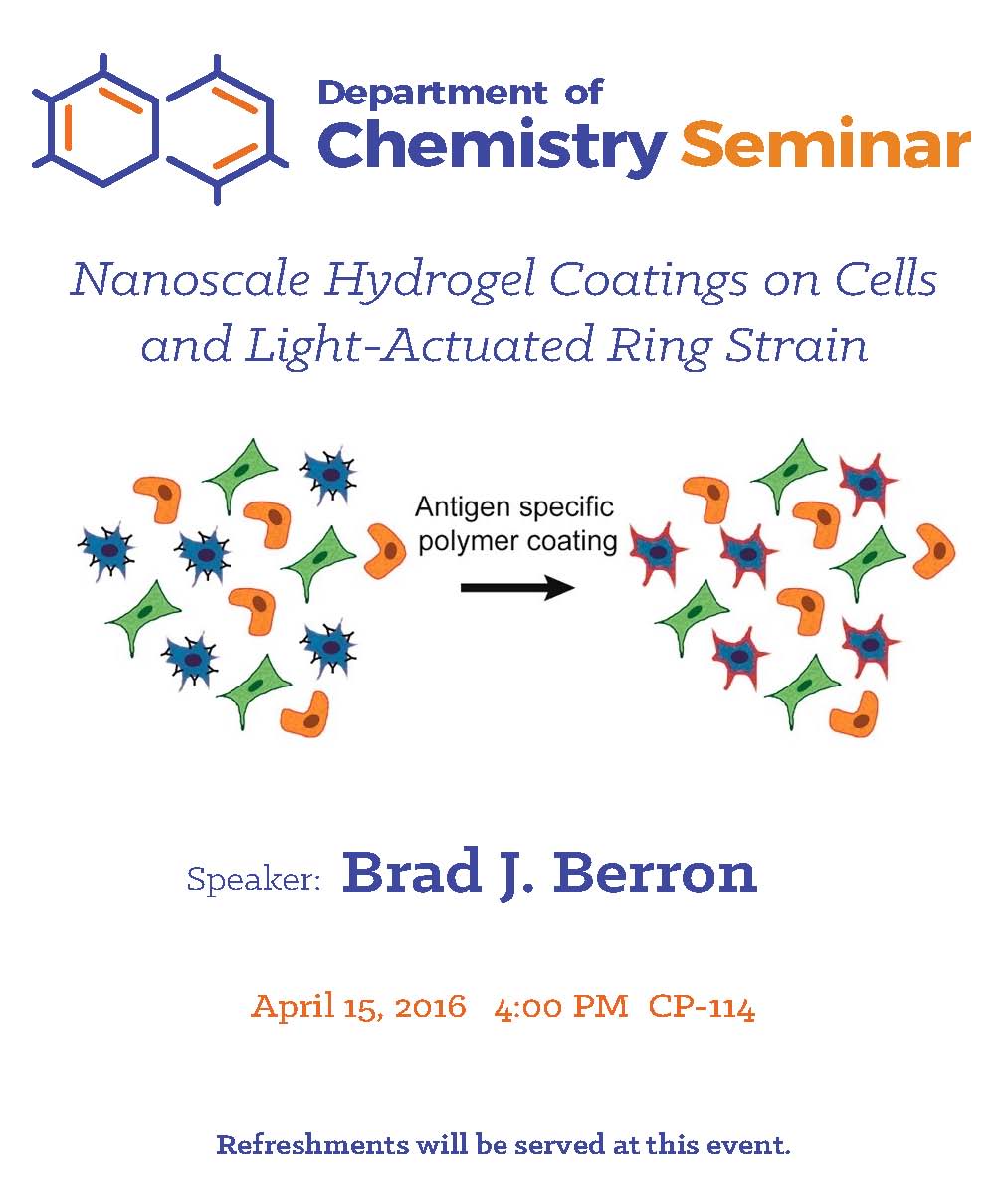
Nanoscale Hydrogel Coatings on Cells
and Light-Actuated Ring Strain
Brad J. Berron
Assistant Professor of Chemical Engineering
Department of Chemical and Materials Engineering
Abstract
The manipulation of biological function on the cellular and subcellular level holds great potential for innovation in medical diagnostics and treatment. Central to this manipulation is the interface of the biological species and its surroundings. Polymeric coatings are obvious choices for biointerfaces as they can mimic the biological environment in structure and chemical functionality and are readily tuned owing to their wide variation in architecture, mechanical properties, surface energy and transport properties.
This talk will focus on the formation of an interfacial polymer network as a tool to control transport of materials at a mammalian cell membrane. The discussion will be is focused on applications of cellular coatings for cellular sorting. An entirely new approach to cellular sorting will be presented that is based on the selective deposition of a protective coating on a cell and the destruction of all unprotected cells. This new batch process takes less than an hour and is readily scaled up to large batch sizes. Critically, the system is designed for high purity, where all uncoated cells are readily lysed. Purities >95% are common when sorting mixtures of cultured cells and for isolation of cells from whole blood. Multiple modes of protection will be discussed, as will their relationship to mechanical properties and molecular transport across the polymer coating.
The second, tenuously-related portion of this talk seeks to combine ring opening metathesis polymerization (ROMP) with photo-responsive molecule to introduce a new class of monomer which is capable of photo-controlled ROMP. Ring strain is a prerequisite for the ROMP monomer activity to minimize reversibility of the metathesis reaction. With this in mind, we are developing monomer with characteristic property of optically tunable ring strain due to inclusion of azobenzene in the cyclic alkene. Our goal is to develop a monomer of controllable polymerization rate based on the irradiation wavelength and intensity. We used computational tools to evaluate the relationship between ring strain and monomer ring size. We support the appropriateness of these calculations through comparison to predictions of experimentally observable phenomenon in comparable materials. We have identified two candidate structures, and we are studying the role of the cis-trans isomerization and in the synthesis of the closed rings, ROMP polymers, and ADMET polymers. Further, the structure of the resulting ADMET or ROMP materials contain an azobenzene in the polymer backbone. These materials are structurally similar to light responsive polymers described by the Neckers lab in the late 1980s, where our materials have an additional internal alkene in the polymer backbone.
Biography
Dr. Berron is an Assistant Professor of Chemical Engineering at the University of Kentucky. His research focuses on polymers and interfacial chemistry, and his work has found a natural fit in the modification of living cell and tissue interfaces. He earned his B.S. in Chemical Engineering from Rose-Hulman Institute of Technology in 2002. He earned his PhD in Chemical Engineering at Vanderbilt University under the direction of G. Kane Jennings in 2008. His research at Vanderbilt on surface modification of electrode surfaces was supported by an NSF fellowship in nanoscale materials science and engineering. Dr. Berron was a postdoctoral researcher at the University of Colorado-Boulder for 3 years where he researched diagnostic assay development in the lab of Christopher N. Bowman. During this time, he earned a position in an NIH training program in pediatric pulmonary disease, where he developed new polymerization mechanisms and approaches appropriate for application in novel diagnostic assays. Following his appointment at UK in the Department of Chemical and Materials Engineering, Dr. Berron was recognized with an NSF CAREER award in the area of biological separations and with a Doctoral New Investigator Award in the field of Surface Science by the American Chemical Society. He has also been awarded an R01 grant from the NIH for his work in cellular coatings.
